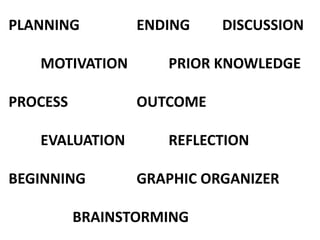This document discusses various aspects of planning, including the definition, purpose, steps, benefits, and challenges of planning. It defines planning as deciding in advance what to do, how to do it, when to do it and who will do it. The main steps in the planning process are to define the task, identify resources, consider alternatives, create the plan, work the plan, and evaluate. Effective planning focuses attention, reduces uncertainty, and guides decision-making. Challenges can include a lack of information, time, resistance to change, and inability to adapt to environmental constraints.





























